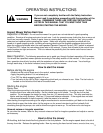
12
WARNING
Service and Adjustments
Tire Maintenance and Pressure
Excessively worn tire tread is dangerous on all hills. Replace drive tires with less than 3/32” of any tread
groove left. Use tires with the tread pattern recommended by Wright Mfg., Inc. only. Keep the tire pressure
in the drive tires between 18 and 22 psi. Higher pressures will cause the tires to have less traction, which
will force you to go slower and with less safety and give you a harder ride. The front casters are equipped
with non-pneumatic tires and do not require any air. They do not have any tread but should be replaced
when excessively worn.
Height-of-Cut
Before adjusting the height-of-cut be sure the mower blades are off, and the rear tires have proper air
pressure. Check for even tire wear. The height-of-cut can be adjusted the following way:
• The cut height is set by allowing the foot lever to rest on a detent pin inserted into the height selection
plates. To set the height of the pin, raise the mower deck to the transport height position and lock in. This
is achieved by pressing the pedal all the way down until the latch system engages the pedal and locks the
deck up in the transport position. With the load removed from the detent pin, it can be changed to the
desired cut height. Once the pin is securely connected to the selector plate, the deck can be lowered to
the desired cutting height by pressing in on the deck-lift foot pedal until the latch releases the pedal. Now
the deck can be lowered until it comes in contact with the pin.
If the deck is leaving stripes, it may be necessary to check the adjustment on the four deck hangers.
Each of the four chain hangers connecting the mower deck to the lift assembly has an adjustable pivot
plate located on the top of the mower deck. On a flat and level surface, the pitch and side-to-side
variation should be checked regularly. Note: it is necessary to have a front to rear pitch of 1/4 inch aiming
the front of the deck toward the ground. Adjust one side at time when setting deck height adjustment.
Belt Tension Adjustment
The pump drive belt is self-adjusting, and requires no adjustment. The blade drive belt is self-adjusting also
and requires no adjustment. Replace tension idler assembly if worn or failing to maintain proper tension.
How to Move the Mower if the Engine Won’t Start
Rotate both of the hydro bypass valve levers on the side of each hydraulic pump about ½ turn
counterclockwise. It is important not to over tighten these levers. Damage may occur to the pump if this
valve is over tightened.
Bleeding Air from the Hydraulic System
Whenever servicing the hydraulic system, it is of the utmost importance to keep any dirt or debris from
getting into the system. Clean off all parts before disassembly and assembly. When any of the hydraulic
parts are disconnected or removed or when the oil is changed, air must be bled from the system. If air is
entrained in the system, loss of power, excessive heat, and damage to the hydraulic pumps may occur.
First, make sure the oil level in the reservoir is correct. The level should be between 1”-1.5” below the top
of the oil fill tube. Use fully synthetic oil: Mobil1 20W-50. Lift the mower so that the rear wheels are off the
ground. Be careful to support the mower so that it will not fall or tip while the system is bled of air. With the
bypass valves open and the engine running, slowly move the control levers back and forth five or six times.
Now close the bypass valves and with the engine running, slowly move the control levers back and forth five
or six times. It may be necessary to repeat the above steps until all the air is purged and the rear wheels
are turning at normal speed. After purging is complete, adjust the oil level in the reservoir if necessary.
Battery Service
The battery is 12 volts and is a maintenance free battery. Charge the battery only if it will not start the
mower effectively. Remove the battery from the mower before charging. Follow the instructions of the


















